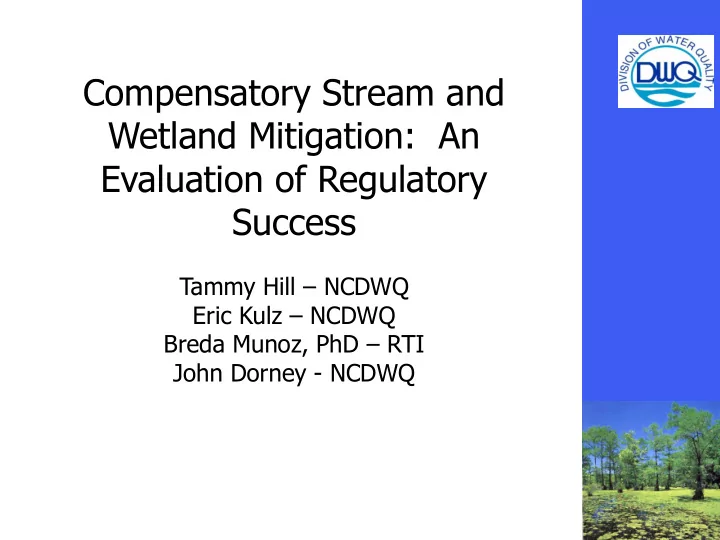

Compensatory Stream and Wetland Mitigation: An Evaluation of Regulatory Success Tammy Hill – NCDWQ Eric Kulz – NCDWQ Breda Munoz, PhD – RTI John Dorney - NCDWQ
USEPA Wetland Program Development Grant Grant for three years (2006-2009) Three staff positions for 401 compliance (ROs) • Assess compliance with conditions in 401 permits Two staff positions for mitigation compliance (CO) • Assess compliance with 401 permit mitigation requirements
Federal Highway Administration (FHWA) Process Review (1995) Process Review Team FHWA, USACE, USFWS, NCDEHNR and NCDOT • Evaluated mitigation for highway projects Selected convenience sample of seven Permits issued 1986-1992 • Reviewed permits, plans • On-site inspections • Evaluation asked two questions: 1) Is site a jurisdictional wetland? 2) Is site the type of wetland designed? Of five sites reported, only one (20%) was successful
Results of 1995 FHWA Process Review Target WL Wetland Type/ Wetland? Target Success? Site Treatment (Y/N) Type (Y/N) Y/N Marsh/ Sneads Ferry Y Y Y Restoration BLH 1 / Evans Road Y N N Creation Pridgen Flats Pocosin/ Partial N N Bank Restoration BLH 1 / US 52 NA 2 Rest. & Y N Bypass Creat. BLH 1 / US 70A Partial N N Restoration 1 BLH = Bottomland Hardwood 2 The reason for NA under the Wetland Target Type is unknown Source: FHWA (1995) Process Review
An Evaluation of Wetlands Permitting and Mitigation Practices in NC (Pfeifer & Kaiser, 1995 ) 59 permits (82 mit . “actions”) reviewed Permits issued between 1/91 and 12/93 41 projects visited 20 projects completed, 14 partially completed Same questions asked as previous study Also considered target wetland size Of 24 projects, only 10 (42%) were successful
Results of Pfeifer & Kaiser Evaluation Source: Pfeifer and Kaiser (1995)
2006 Implementation Grant Tasks Compile and organize mitigation files Develop and populate mitigation database Develop site inspection forms Establish target population for study • Projects permitted 1/96 – 12/06
2006-2007 Implementation Grant Tasks Determine app. sample size (95% conf.) Stratify by proportions • Mitigation providers Select sample sites (random number gen.) Determine sites not evaluated • Duplicates • Not mitigation projects • Projects not constructed yet • Projects constructed recently (<1-2 yrs. old)
By the Numbers……. Population 130 wetland sites 193 stream sites Sample Size 98 wetland sites 129 stream sites After removal of sites not evaluated……
Final Numbers - Wetlands 82 Wetland Sites 205 components; >20,000 acres
Final Numbers - Streams 79 Stream Sites 136 components; ≈600,000 linear ft
“Regulatory” Success Problem: Defining “Success” Decision: At the time of the site visit, the site was meeting the success criteria approved in the original restoration plan
Overall Success Rates Mitigation Components (numbers) Wetlands 74% (70% excluding P) Streams 75% (74% excluding P) Mitigation Area or Length (size) Wetlands 70% (64% excluding P) Streams 84% (75% excluding P)
Success Rates by Provider By component counts: No significant difference
Success Rates by Provider By size, private mitigation had a statistically significantly higher success rate than: • NCDOT off-site wetland mitigation • EEP/WRP DBB stream mitigation (only w/ P included)
Success Rates by Physiographic Region By component count: No significant differences By size: Piedmont streams & Mountain wetlands had lower success rates than other regions
Success Rates by Mitigation Activity Preservation most successful (stream & WL) Wetlands: no other significant differences Streams: Enhancement had a significantly higher success rate than restoration
Success Rates By Age Streams: No significant differences Wetlands: By size, newer projects less successful than older projects
Other Variables Project Size: No statistically significant difference in success rates Ecosystem Type (Wetlands): No significant difference between riparian, non-riparian, coastal WL River Basins/Ecoregions: Sample sizes too small to yield conclusive results
Statistics Summary Wetland success not statistically higher than stream success Preservation is very successful Stream enhancement more successful than stream restoration Piedmont stream mitigation less successful than Mtns and Coastal Plain No significant difference between mitigation providers, except as noted
Discussion Impractical to assume every acre/linear foot of mitigation will be successful Wetland mitigation success much improved since 1995 studies Stream success lower in Piedmont • More bank erosion/structure failure • More difficulty establishing woody veg • Particularly observed where site excavation required (e.g. “Priority 2” restoration)
Discussion Longer monitoring periods likely warranted Updated monitoring and success criteria needed Greater regulatory oversight/input needed Improved recordkeeping and access to data needed
Comments Final report has been posted on DWQ Website: http://portal.ncdenr.org/web/wq/swp/ ws/401/certsandpermits/mitigation Version of report submitted to Environmental Management for publication in October 2011 (still in review).
Questions??
Recommend
More recommend